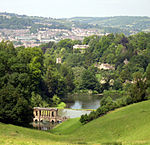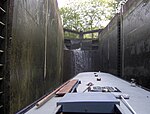Bath Abbey Cemetery

The Anglican Bath Abbey Cemetery, officially dedicated as the Cemetery of St Peter and St Paul (the patron saints that Bath Abbey is dedicated to), was laid out by noted cemetery designer and landscape architect John Claudius Loudon (1783–1843) between 1843 and 1844 on a picturesque hillside site overlooking Bath, Somerset, England. The cemetery was consecrated on 30 January 1844. It was a private Anglican cemetery financed by W. J. Broderick, Rector of Bath Abbey. The layout is a mixture of formal and informal arranged along a central avenue. It features a mortuary chapel, designed by Bath City Architect G. P. Manners in the then fashionable Norman Revival architectural style.
Excerpt from the Wikipedia article Bath Abbey Cemetery (License: CC BY-SA 3.0, Authors, Images).Bath Abbey Cemetery
Pope's Walk, Bath Lyncombe Vale
Geographical coordinates (GPS) Address Nearby Places Show on map
Geographical coordinates (GPS)
| Latitude | Longitude |
|---|---|
| N 51.3701 ° | E -2.3481 ° |
Address
The Mortuary Chapel
Pope's Walk
BA2 5AZ Bath, Lyncombe Vale
England, United Kingdom
Open on Google Maps










